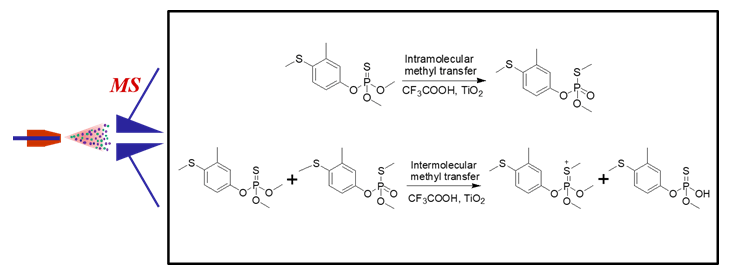| [1] Dakternieks, D.; Lim, A. E. K.; Lim, K. F. Chem. Commun. 1999, 15, 1425.
[2] Shekar, S.; Brown, S. N. J. Org. Chem. 2014, 79, 12047.
[3] Schmidt, T.; Schwede, T.; Meuwly, M. J. Phys. Chem. B 2014, 118, 5882.
[4] Lukinavicius, G.; Lapiene, V.; Stasevskij, Z.; Dalhoff, C.; Weinhold, E.; Klimasauskas, S. J. Am. Chem. Soc. 2007, 129, 2758.
[5] Khaskin, E.; Zavalij, P. Y.; Vedernikov, A. N. J. Am. Chem. Soc. 2008, 130, 10088.
[6] Shekar, S.; Brown, S. N. Organometallics 2013, 32, 556.
[7] Jones, P. A.; Takai, D. Science 2001, 293, 1068.
[8] Klose, R. J.; Bird, A. P. Trends Biochem. Sci. 2006, 31, 89.
[9] Finnegan, E. J.; Peacock, W. J.; Dennis, E. S. Curr. Opin. Genet. Dev. 2000, 10, 217.
[10] Xiong, L.; Ping, L.; Yuan, B.; Wang, Y. J. Am. Soc. Mass Spectrom. 2009, 20, 1172.
[11] Hughes, R. M.; Waters, M. L. J. Am. Chem. Soc. 2005, 127, 6518.
[12] Callahan, B. P.; Wolfenden, R. J. Am. Chem. Soc. 2003, 125, 310.
[13] Zhang, X.; Wang, H.; Liao, Y.; Ji, H.; Guo, Y. J. Mass Spectrom. 2010, 42, 218.
[14] Kshirsagar, U. A.; Argade, N. P. Tetrahedron 2009, 65, 5244.
[15] Zhang, X. J. Mol. Struc.-Theochem. 2010, 955, 91.
[16] Zhang, X.; Yao, S.; Guo, Y. Int. J. Mass Spectrom. 2008, 270, 31.
[17] Reepmeyer, J. C. Rapid Commun. Mass Spectrom. 2010, 23, 927.
[18] Gao, X.; Zhu, G.; Zeng, Z.; Chen, W.; Lin, Z.; Liu, Y.; Xu, P.; Zhao, Y. Rapid Commun. Mass Spectrom. 2011, 25, 1061.
[19] Ammal, S. C.; Yamataka, H.; Aida, M. A.; Dupuis, M. Science 2003, 299, 1555.
[20] Kitamura, S.; Kadota, T.; Yoshida, M.; Jinno, N.; Ohta, S. Comp. Biochem. Phys. C 2000, 126, 259.
[21] Bai, C. L.; Qiao, C. B.; Zhang, W. D.; Chen, Y. L.; Qu, S. X. Biomed. Environ. Sci. 1990, 3, 262.
[22] Ben Amara, I.; Sefi, M.; Troudi, A.; Soudani, N.; Boudawara, T.; Zeghal, N. Indian J. Biochem. Bio. 2014, 51, 293.
[23] Cheke, R. A.; Mcwilliam, A. N.; Mbereki, C.; Van Der Walt, E.; Mtobesya, B.; Magoma, R. N.; Young, S.; Eberly, J. P. Ecotoxicology 2012, 21, 1761.
[24] Celik, I.; Isik, I.; Ozok, N.; Kaya, M. S. Toxicol. Ind. Health 2011, 27, 357.
[25] Eckstein, F.; Gish, G. Trends Biochem. Sci. 1989, 14, 97.
[26] Frey, P. A.; Sammons, R. D. Science 1985, 228, 541.
[27] Wilkins, E.; Carter, M.; Voss, J.; Ivnitski, D. Electrochem. Commun. 2000, 2, 786.
[28] Chen, P. S.; Huang, S. D. Talanta 2006, 69, 669.
[29] Salm, P.; Taylor, P. J.; Roberts, D.; Silva, J. D. J. Chromatogr. B 2009, 877, 568.
[30] You, Z.-S.; Wen, Y.-J.; Jiang, K.-Z.; Pan, Y.-J. Chin. Sci. Bull. 2012, 57, 1183. (尤珠双, 文永均, 蒋可志, 潘远江, 科学通报, 2012, 57, 1183.)
[31] Zhang, J.; Chai, Y. F.; Wang, W.; Shang, W.; Pan, Y. J. Chinese J. Chem. 2012, 30, 2383.
[32] Chai, Y.-F.; Gan, S.-F.; Pan, Y.-J. Acta Chim. Sinica 2012, 70, 1805. (柴云峰, 甘世凤, 潘远江, 化学学报, 2012, 70, 1805.)
[33] Yin, X.-C.; Jiang, Y.; Chu, S.-Y.; Weng, G.-F.; Fang, X.; Pan, Y.-J. Acta Chim. Sinica 2018, 76, 436. (尹欣驰, 江游, 楚士颖, 翁国锋, 方向, 潘远江, 化学学报, 2018, 76, 436.)
[34] Zhang, X. P.; Chen, H. H.; Ji, Y.; Jiang, K. Z.; Chen, H. W. J. Am. Soc. Mass Spectrom. 2018, doi.org/10.1007/s13361-018-2098-4.
[35] Newman, M. S.; Karnes, H. A. J. Org. Chem. 1966, 31, 3980. |
